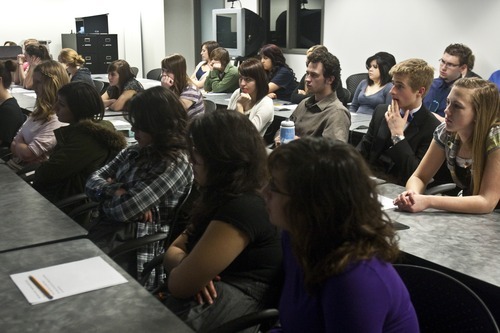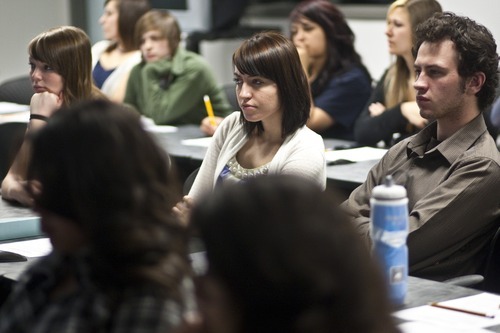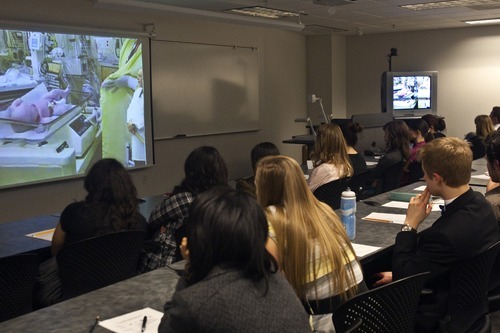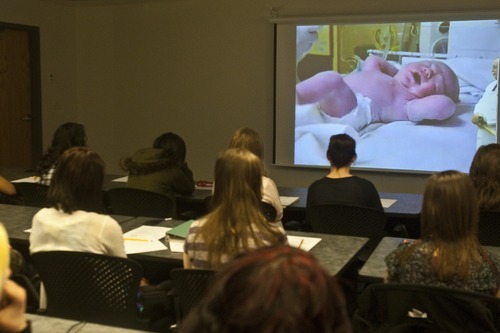This is an archived article that was published on sltrib.com in 2011, and information in the article may be outdated. It is provided only for personal research purposes and may not be reprinted.
It's a sight that has inspired prayer and provoked fear. It's made grown men faint and women weep.
But on Wednesday, more than 360 mere teenagers from across the state watched two women give birth — one vaginally and one through cesarean section — with mostly fascinated, clinical detachment.
"It's the medical profession. It's not anything to be embarrassed about," said Granger High School senior Andrew Marstella, 18, after watching the two births, up close on a big screen, in a classroom at Granite Technical Institute.
The prerecorded births were simultaneously broadcast Wednesday to 10 school sites throughout Utah, along with doctors who explained — live — what was happening and then took video questions from students.
The idea behind the broadcast, hosted by the state Office of Education and Intermountain Healthcare, was to give teens interested in medical careers a taste of what may be in store for them, especially because so many say they want to work in labor and delivery, said Thalea Longhurst, a health science education specialist at the state office. This was the sixth time medical procedures have been broadcast to Utah high schools through the program.
"We want them to see what they can't see by reading a textbook," Longhurst said. "Until they actually see it happening, it's not real to them."
To take part, students in health-science courses had to get parental permission and participate in lessons leading up to the event, designed to prepare them for what they would see. Students at the Granite Technical Institute screening attended the two-hour lessons after school, once a week for a month.
Still, for some, the broadcast Wednesday was a lot to take in. Students first watched a woman, shown only from the waist down, giving birth vaginally. They watched the doctor stretch, pull and prod until a wiggly, pink baby finally emerged. Next, they watched doctors prepare a woman for a cesarean section, again only from the waist down. They saw doctors make the cuts, pull out the baby, close up the uterus and finally close the woman's incisions.
Two woozy students quietly left the Granite event in midprocedure.
But most of the students, at Granite and the other nine broadcast sites throughout the state, remained stolid, taking notes and asking doctors Anne Anderson and Steven Kammeyer questions afterward. Students at each site pressed buttons on devices at their desks to ask questions. Cameras allowed the students — from 18 schools — to see each of the other classrooms as they took turns talking to the doctors on-screen.
Questions ranged from highly technical to sentimental.
A girl from Rich High asked how large a woman's uterus becomes during pregnancy. Kammeyer answered that it can stretch from about the size of a pear to about 37 centimeters — 14.6 inches — for an average-size baby.
A student from Riverton High wondered how many babies Kammeyer delivers each day. He said usually not more than two, but he said he stopped counting after the total number eclipsed 10,000.
A girl from Highland High asked the doctors what they liked best about their jobs. Anderson, who works in pedia-trics/neonatology, said she enjoys seeing tiny, premature babies grow. Said Kammeyer: "I still think watching the birth of a baby is such a miracle [that] every time I see it, I marvel at it."
Many of the students said afterward the viewing reinforced their desire to work in health care.
"I was really excited because not many people have this opportunity," said Rachel Thackeray, a Highland High senior who hopes to go into medicine.
Siosiani Sili, a senior at Granger High who wants to become a pediatrician, said the blood and guts didn't bother her, especially because she's already watched her sister give birth. "It was a really good experience just to be able to talk to the doctors, one-on-one," Sili said.
Each year, students get to see one of a number of different prerecorded surgeries as part of the program. This was the second time the birth video has been shown. It's a broadcast that Julie Bagley, a counselor and health-science specialist at Granite Technical Institute, has found tends to be more popular among girls than boys.
Only three boys watched Wednesday. "A lot of teenage boys are not ready to look at this in a kind of objective way," Bagley said. "I was proud of the ones that did come."









